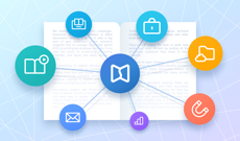Every day, we witness how new technological advances are making our lives more comfortable and giving us more opportunities for efficient work and daily tasks. However, we must always keep in mind that new technology brings responsibility for our society and planet. That’s where digital sustainability comes into play. So let’s see what digital sustainability is, what principles the business can follow, and how we at FlippingBook help our clients go green.
What Is Digital Sustainability?
Digital sustainability refers to the practice of using digital technologies and solutions in a way that minimizes their environmental impact, including energy consumption, e-waste generation, and carbon emissions while promoting efficient resource use.
In an economic context, digital sustainability can be defined as leveraging digital innovations to create sustainable business models that support long-term profitability and consider environmental and social impacts.
Digital Sustainability Strategies for Every Business to Follow
If you want to make your business more sustainable, start by reviewing digital sustainability strategies and see what you can implement. These principles help organizations and individuals align their sustainable marketing strategies with broader sustainability goals. Here are some key aspects:
💚User empowerment: provide your clients with tools and information to make informed choices about their digital consumption and its environmental impact.
💚Collaboration for impact: engage stakeholders across sectors to share innovations, and resources for achieving sustainability goals.
💚Long-term thinking: consider the long-term implications of digital technologies on society and the environment in decision-making processes.
💚Innovation for sustainability: foster research and sustainable business practices that address environmental challenges, such as climate change or resource scarcity.
💚Transparency and accountability: promote open communication about your sustainability practices and impacts related to digital technologies, and share your best practices with clients and investors through sustainable marketing and promo campaigns.
💚Energy efficiency: prioritize energy-efficient technologies and practices in data centers, cloud computing, and device usage to reduce carbon footprints.
💚Inclusive design: develop digital products and services that are accessible to all users, regardless of ability, age, or socio-economic status.
💚Circular economy: encourage the reuse, recycling, and refurbishing of digital devices and components to minimize waste and resource depletion.
💚Ethical data use: ensure responsible collection, storage, and usage of data, with a focus on privacy, security, and consent.
💚Sustainable supply chains: assess and choose suppliers based on their environmental and social practices to ensure responsible sourcing of materials.
FlippingBook as a Sustainable Solution
At FlippingBook, we’re also committed to helping our clients become more eco-friendly. FlippingBook is an online service for creating interactive online documents that allows our clients to print less and go digital with their content. Thus, they can be more sustainable in their marketing and sales activities. It’s a great way to support green and sustainability initiatives by moving away from printing and starting to digitize catalogs, brochures, magazines, or any other documents. 💚
As one of our clients, Bianca U, Marketing Specialist, says about FlippingBook:
It solves the environmental issue of over-printing. It also makes our content accessible nationwide.
Plus, printing less saves costs and time. Imagine that you don’t need to print your 300-page catalog and send it via post anymore—instead, you simply share the digital version of your catalog with everyone via email. Just in a few clicks. This way, you have more time and money to support green initiatives in your community and become a sustainable, eco-friendly company.
Another customer, Nicky Y, Marketing and Outreach Coordinator, shares how their company saves costs with FlippingBook:
Our firm used to mail out packets to each potential client that would cost close to $10.00 for each—since FlippingBook was created we now can email them and save!
How We Help Our Customers Become Sustainable
We’re proud to be able to help our clients achieve great goals in becoming environmentally friendly companies and having a positive impact on the environment. Here are several sustainability examples with stories and feedback from three of our customers.
Gavinho Architecture & Interiors
Gavinho, a Lisbon-based architecture and interior design studio, creates signature spaces while carrying the idea of sustainability at heart.
The studio uses a lot of Portuguese materials, mainly materials that can age properly, like stone, wood, or cork. For them, the concept of sustainability is not recycling something over and over, it’s more about using materials that last one hundred, five hundred years—the longest possible.
So naturally, Gavinho’s presentations needed to be digitally sustainable, too—and that’s where FlippingBook came into play. The business is purely visual, so Gavinho strives to present their projects in the best format to every client. Presentations made with FlippingBook help Gavinho tell the project’s story in an immersive and engaging way, simultaneously reducing the ecological footprint. Inês Félix Gavinho, Creative Director at Gavinho, describes how FlippingBook helps them become more sustainable:
FlippingBook helps a lot in terms of sustainability because I don’t have to print, I’m not wasting paper. I can send it in five seconds to a client or a person on the other side of the world. What we aim is really to transport people through that journey of reading the story that we’re trying to tell them.
Schréder
As a leading independent outdoor lighting solution provider, one of our clients, Schréder believes that lighting can impact lives, support communities, and transform spaces, cities, and the planet. The team at Schréder are experts at using light to its fullest potential to bring meaningful moments to people in public spaces. 💡
Schréder’s advanced and sustainable solutions evolve quickly, so the company seeks to use innovative tools in its work and reduce its ecological footprint, so FlippingBook turned out to be a perfect match. As Stéphane Halleux, integrated communication manager at Schréder, says:
Any opportunity to get the right content in front of our audience to inspire, inform, or simply raise awareness about our offer or solution is made really easy with FlippingBook.
💚 Learn more about Schréder's journey with FlippingBook
Check our customer story on how FlippingBook helps Schréder lead the way to a sustainable future.
Food Huggers
Another client who uses FlippingBook to meet their sustainability goals is Food Huggers. The company designs food-saving products to replace single-use plastics with high-quality reusable alternatives while keeping your food fresh longer. By providing simple tools for reducing waste and promoting sustainable food, they help make sustainable habits easy, convenient, and fun. Food Huggers creates online product catalogs with FlippingBook to keep retailers and wholesale customers up-to-date on the latest product line additions and practice sustainability as a company.
Print less and go digital with FlippingBook
Loni Slatkin, Communications Manager, shares her experience of working with FlippingBook:
We’re, at our core, a sustainable company and we try to reduce our footprint wherever we can. FlippingBook helps make this possible by serving as a useful tool to make the digitalization of our catalog effortless.’
As you see, working for a greener future together isn’t hard at all. We hope that our article will help you see what you can do as an individual or a company to support the sustainability cause. Good luck!




